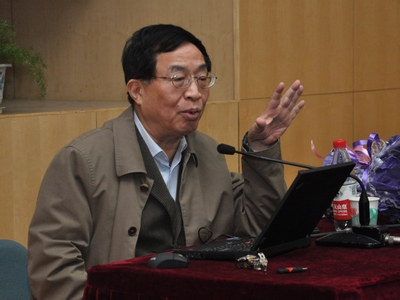Peking University, Dec. 10, 2010: “Chang’e’s flying to the moon is crucial to China’s international status, and the ‘Chang’e spirit’ could be regarded as a significant treasure of the Chinese people.”
That was a comment on China’s lunar exploration project made by Prof. Ye Peijian, member of the Chinese Academy of Sciences, and chief designer of the Chang'e probes.
His speech at Peking University on the afternoon of Dec. 3 was part of the 2010 PKU Cultural Month of Information and Engineering Sciences. Prof. Mei Hong, dean of School of Electronics Engineering and Computer Science (EECS), presided over the lecture.

Prof. Ye Peijian delivered a speech
As chief designer of the Chang’e Project, Prof. Ye Peijian explained why the human race should explore the space, and introduced the development history and main achievements of China’s space cause. Along with a summary of similar developments overseas, Prof. Ye Peijian focused on China’s Chang’e Project of lunar exploration, including the scientific and engineering goals of its first stage (lunar orbiting exploration) and basic information, history of research and main technical achievements of Chang’e-1 probe; basic content and key technologies of Chang’e-2 probe in the second stage (lunar landing) and the research ideas about the third stage (retrieving the probe). The speech was concluded by a description of China’s long-term vision and technical approaches of space exploration, followed by a Q&A session.
This event is one of the lecture series of renowned academicians in the area of information technology and informationization, aiming at publicizing the culture of information science, fostering academic communication, and inspiring students to devote themselves to science and technology of the country. A number of Nobel Prize winners and members of CAS and of CAE will visit PKU for the cultural month.

Long March 3C rocket carrying China's second unmanned lunar probe, Chang'e-2, lifts off from the launch pad at the Xichang Satellite Launch Center in southwest China's Sichuan Province, at 18:59:57 (Beijing time) on Oct. 1, 2010. (Xinhua/Li Gang)
China launched its second unmanned lunar probe, Chang'e-2 on Oct. 1, 2010, inaugurating the second phase of a three-step moon mission, which will culminate in a soft-landing on the moon.
Chang'e is the Chinese goddess of the moon. Unlike many lunar deities in other cultures who personify the moon, Chang'e only lives on the moon.
The moon goddess was mentioned in the conversation between Houston Capcom and Apollo-11 crew just before the first moon landing by the US:
Houston : Among the large headlines concerning Apollo this morning there's one asking that you watch for a lovely lady with a big rabbit. An ancient legend says a beautiful Chinese lady called Chang'e has been living there for 4,000 years. It seems she was banished to the moon because she stole the pill for immortality from her husband. You might also look for her companion, a large Chinese rabbit, who is easy to spot since he is only standing on his hind feet in the shade of a cinnamon tree. The name of the rabbit is not recorded.
Collins : Okay, we'll keep a close eye for the bunny lady.
Extended Reading:
PKU Cultural Month of Information and Engineering Sciences
Related Video:
Ye Peijian, chief designer of China's lunar probes: Dream of flying to the moon nearer
Translated by: Chen Long
Edited by: Jacques
Source: PKU News (Chinese)